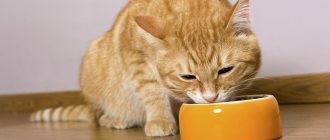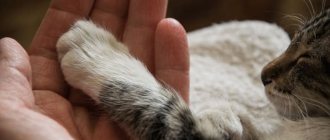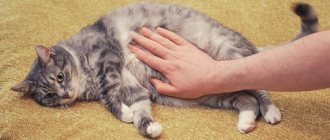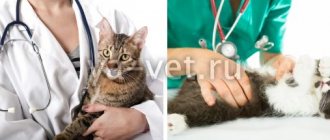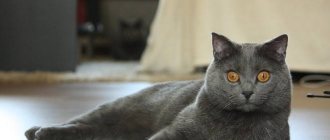Healthy cats are full of activity and appear cheerful. Any disease, even a minor one, always affects the behavior of the animal. An attentive owner will definitely notice alarming symptoms and seek medical help from a veterinary clinic.
- 2 What diseases do cats have
2.1 Video: skin diseases in cats
- 3.1 Table: common cat diseases and their characteristic symptoms
How to understand that a cat is sick
A cat can get sick at any age. And also the development of pathologies does not depend on the breed of the animal. If your cat’s health deteriorates, the following general signs may be observed:
- lethargy of the animal;
- poor appetite;
- anxiety;
- sleep disturbance.
If a cat refuses a favorite treat, this should alert the owner
Clinical signs of various diseases
Depending on the clinical signs, the owner can guess what illness the cat has.
Table: common cat diseases and their characteristic symptoms
| Name of the disease | Symptoms |
| Cat affected by ear mites |
|
| Fleas on a cat |
|
| Nematodes |
|
| Kidney diseases |
|
| Type I diabetes |
|
| Type II diabetes |
|
| Heart diseases |
|
| Colitis |
|
| Gastritis |
|
| Conjunctivitis |
|
| Blepharitis | At the initial stage of the disease, the eyelids become covered with purulent crusts. As the pathology develops, purulent crusts are replaced by an ulcerative surface. Other symptoms:
|
| Third eyelid prolapse |
|
| Otitis |
|
| Ear abscess |
|
| Rabies |
|
| Calcivirosis |
|
| Panleukopenia |
|
| Ringworm |
|
| Dermatitis |
|
| Uterine torsion |
|
| Uterine hernia |
|
| Vaginitis |
|
| Diseases of the musculoskeletal system |
|
Photo gallery: symptoms of feline pathologies
Fleas are small in size and brown in color
Blepharitis is characterized by redness of a cat's eyelids.
When a cat's third eyelid prolapses, the mucous membrane in the inner corner of the eye turns red
Increased thirst in a cat may indicate the development of type I diabetes
Vomiting in an animal can be a symptom of kidney pathologies
Rabies in cats is accompanied by the formation of foam at the mouth
Ringworm causes partial baldness of the animal.
Dermatitis causes ulcers and blisters to appear on your cat's skin.
With conjunctivitis, a cat may experience purulent discharge from the eyes.
Blood disorders
A low level of hemoglobin, a small number of red blood cells or their rapid destruction are very dangerous. These disorders are fraught with retarded growth and development, decreased immunity and hypoxic coma caused by lack of oxygen.
Anemia
Anemia is accompanied by pallor of the mucous membranes and delayed physical development. This pathology is often inherited or occurs as a complication of helminthiasis.
The condition of sick babies can be normalized with the help of iron. To do this, you need to select a special medicinal food or add iron-containing supplements to the diet.
Hemolysis
Occurs when the blood type of a mother cat and her cubs do not match. Antibodies that enter the body along with colostrum attack and destroy the red blood cells of newborns.
The destruction of red blood cells is accompanied by:
- yellowing of mucous membranes;
- darkening of urine to a brown tint;
- lethargy and refusal to feed;
- necrosis of tissue at the tip of the tail.
The cubs should be transferred to artificial feeding. It is also recommended to take blood tests for the entire family in advance to rule out breastfeeding without waiting for complications.
Diseases transmitted from cats to humans
There are cat diseases that can be transmitted from the animal to the owner:
- worms;
- conjunctivitis;
- blepharitis;
- rabies. The virus can be transmitted to a person if an infected cat scratches or bites him. The symptoms of the disease in humans are the same as in cats. It is impossible to save an infected person; the disease ends in death.
To avoid infection when contacting a sick cat, you must follow the following safety rules:
- wash your hands with soap after petting an animal;
- carry out manipulations to treat the cat (combing, washing and eye drops) wearing medical gloves.
To avoid contracting conjunctivitis or blepharitis from a cat, it is necessary to apply eye drops to the animal using medical gloves.
What are the most common diseases in kittens?
Kittens can also be susceptible to various diseases. However, the most common pathologies observed in children are:
- upper respiratory tract infections;
- worms;
- flea damage to the skin;
- colitis.
To help the kitten, you should not hesitate and seek medical help from a veterinarian.
The immune system of kittens is in the formative stage, so the body’s defenses are weakened. This causes frequent respiratory diseases.
Hypogalactia
Such a tricky name hides a very simple reason - lack of lactation in a nursing mother. Milk deficiency leads to malnutrition and malnutrition in babies.
Causes of hypogalactia:
- The cat is primiparous.
- The nursing animal has poor nutrition.
- The litter is too numerous.
To get rid of the problem, you need to provide the mother with a nutritious diet, rich in protein and carbohydrate foods, and supplement the kittens with artificial feeding. At one month of age, you can start introducing complementary foods.
What pathologies are older cats susceptible to?
Older cats have an increased risk of developing the following diseases:
- diseases of the musculoskeletal system. Metabolism in cats becomes disrupted as they age, which can lead to a decrease in calcium and phosphorus levels in the blood. The lack of these beneficial substances leads to the destruction of bone and cartilage tissue;
- heart pathologies. Elderly cats are often diagnosed with high blood pressure, which can cause problems with the cardiovascular system;
- diabetes mellitus type II. Many older cats don't exercise much and are therefore susceptible to becoming overweight;
- chronic renal failure. As cats age, blood circulation may deteriorate, which often causes a decrease in the excretory capacity of the kidneys.
Old age is an additional factor in the development of diseases in cats
Prevention
To reduce the risk of developing diseases in your beloved pets, follow these recommendations:
- Visit your veterinarian regularly for preventative medical examinations;
- Make sure your cat's diet is balanced;
- do not allow the animal to become obese;
- To prevent worms, do not use raw meat and fish in your cat’s diet. When feeding your animal dry food, pay attention to the expiration date of the food product;
- Do not refuse mandatory vaccinations for cats. For example, you can only protect yourself from rabies through vaccination.
Vaccination will help protect your pet from dangerous diseases.
The outcome of any cat disease primarily depends on the competent actions of the owner: if any pathological signs appear in the animal, you should consult a specialist.
Diseases of the skin and coat. Allergic reactions
The skin and fur of cats are a natural barrier that protects the body from the negative effects of environmental factors. In addition to protective, the skin performs thermoregulatory, excretory, and receptor functions. Many metabolic processes take place in the skin, which in one way or another affect the functioning of all body systems. It is not surprising that general ill health and metabolic imbalances often manifest themselves in the form of deterioration in the quality of the skin. The main symptoms of skin and coat pathologies are:
- itching The animal becomes restless and constantly scratches itself;
- changes in the appearance of certain areas of the skin, rashes, formation of redness, weeping spots, swelling, etc.;
- the appearance of a large amount of dandruff and/or sebum;
- excessive shedding;
- complete loss of hair in certain areas (focal baldness).
These signs can be both symptoms of severe systemic diseases (for example, allergies) and true skin problems, for example, flea or tick infestation, fungal skin infections, injuries and burns.
The treatment that a veterinarian can prescribe for a cat will be mainly aimed at eliminating the root cause of the pathology and relieving symptoms.
Prevention of skin diseases includes regular treatment of the animal for parasites, preventing the cat from coming into contact with caustic substances and dangerous objects, and providing balanced feeding.
Diets suitable for cats with problem skin should have the following characteristics:
- sufficient vitamin A and zinc content - promotes better skin regeneration, necessary for collagen synthesis;
- high content of polyunsaturated fatty acids (omega-3 and omega-6) – reduces skin inflammation and improves coat quality;
- high content of antioxidants (vit. E and vitamin C) – enhances the protection of skin cells from the harmful effects of free radicals;
- high protein content to ensure regenerative processes.
The Purina® PRO PLAN® Cat® line of foods are perfectly balanced to provide all body functions, including healthy skin. For animals with problem skin, the Purina® PRO PLAN® Derma Plus® specialized diet is especially suitable. It contains salmon meat as a source of protein, which ensures excellent taste of the food and additionally saturates the diet with polyunsaturated fatty acids. A limited amount of protein sources in the diet reduces its potential allergenicity, which has a beneficial effect on the health of cats with sensitive skin. It has been proven that animals that consume Purina® PRO PLAN® Derma Plus® on an ongoing basis significantly improve the quality of their skin and normalize the molting process.
It is worth noting that manifestations of allergic reactions include not only diseases of the skin and its integument, but also diseases of a variety of organ systems, for example, respiratory, digestive. This means that allergies can also manifest themselves in the form of conjunctivitis, sneezing, coughing, vomiting and diarrhea. A veterinarian will help you identify an allergic disease in a timely manner and prescribe qualified therapy.


